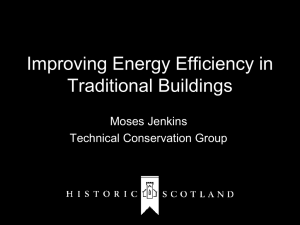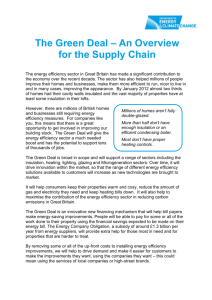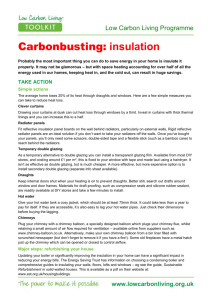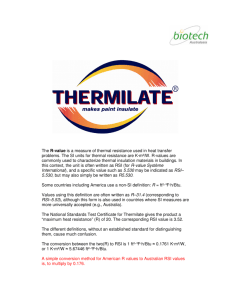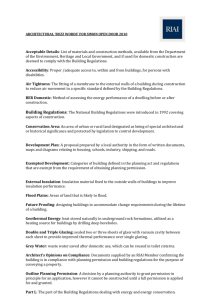Chapter 4 Problem Set (Buildings)
advertisement
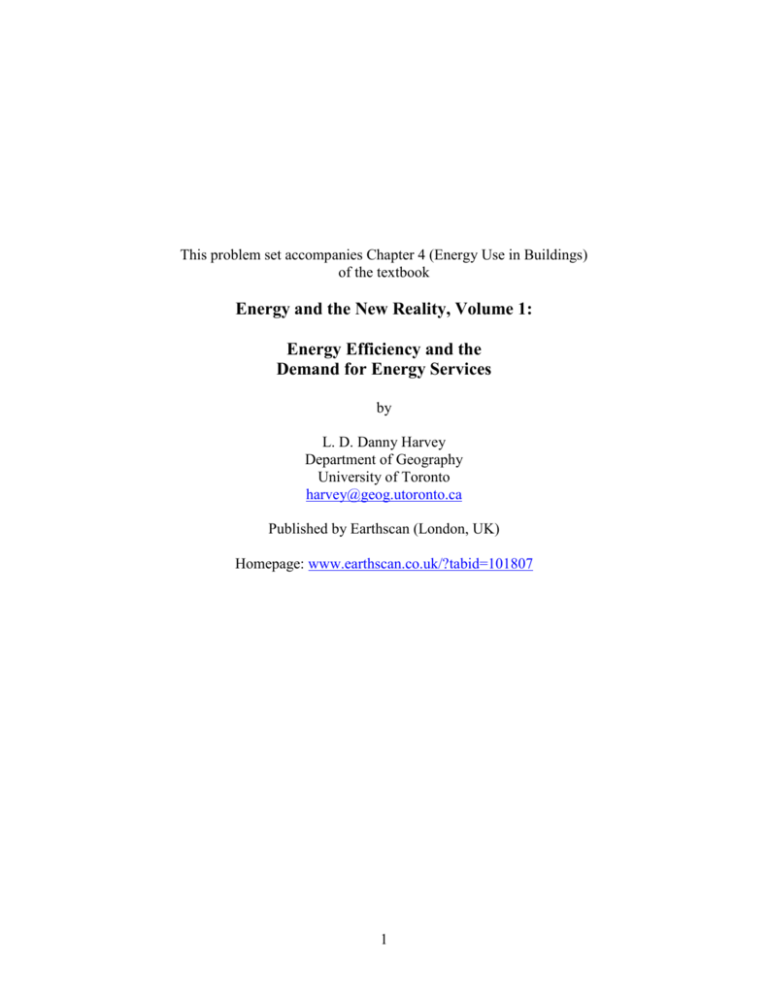
This problem set accompanies Chapter 4 (Energy Use in Buildings) of the textbook Energy and the New Reality, Volume 1: Energy Efficiency and the Demand for Energy Services by L. D. Danny Harvey Department of Geography University of Toronto harvey@geog.utoronto.ca Published by Earthscan (London, UK) Homepage: www.earthscan.co.uk/?tabid=101807 1 Problem Set 3 – Energy Use in Buildings Assigned: Additional meetings: Due: Taken up: Part 1. Heat loss through a window or wall: Basic principles – 1. Heat flow can be computed either as a temperature difference (K) times a U-value (W/m2/K), or as a temperature difference divided by a resistance (R). 2. The U-value is equal to the reciprocal of the resistance, and vice versa 3. For simultaneous heat flow processes (such as conduction and radiative heat transfer) we speak of heat transfer coefficients, but these have the same units as U-values 4. For simultaneous heat flow processes, just add the heat transfer coefficients, then take the reciprocal to get the total resistance for that layer 5. For sequential heat flow processes (such as heat transfer through successive layers of a window or wall), just add the resistances of each layer to get the total resistance. 6. To get the overall U-value for the entire window or wall assembly, take the reciprocal of the total resistance. The heat flow through a window involves (a) conductive (or convective) heat transfer between the glass surface and adjacent air, (b) emission of infrared radiation from the glass surface, and (c) molecular conduction through the glass layers. By convention, window surfaces are numbered from the outside inward. The heat flow and the steps in computing the overall U-value are represented by the following circuit diagram: T1 T2 T3 T4 T out T in Hoc R2 h c23 R4 h ic h or h r23 h o=h oc +hor h 23=h o23+h r23 h i =h ic+h ir R3=1/h 23 R5=1/h i R1=1/h o h ir Rtotal =R1 +R2 +R3 +R4 +R5 U-value=1/R total In this diagram, - hoc is the heat transfer coefficient for conductive/convective heat transfer between the outside air and window surface 1, and is computed as 4.1V W/m2/K (V=wind speed, m/s) - hic is the heat transfer coefficient for conductive/convective heat transfer between the inside air and window surface 4, and is given a fixed value of 3 W/m2/K - hor and hir are the heat transfer coefficients for radiative heat transfer between the outside air and window surface 1 or between the inside air and window surface 4, respectively, 2 - and are computed as 5.3ε/εb, where ε is the emissivity of the window surface in question and εb is a fixed value of 0.845 (equal to the emissivity of an uncoated window surface) hc23 is the heat transfer coefficient for conductive/convective heat transfer between glazing surfaces 2 and 3 of a double-glazed window, and is computed as hc 23 - Nk L where N is the Nusselt number (taken here to be fixed at 1.3), k is the thermal conductivity (W/m/K) of the gas between the 2 glazing layers (values for air, argon, and krypton are given in the Excel worksheet), and L is distance (m) between the two panes of glass (also given in the Excel worksheet). hr23 is the heat transfer coefficient for radiative heat exchange between glazing surfaces 2 and 3 of a double-glazed window, and is computed as 1 1 1 hr 23 4 1 T 3 2 3 where σ is the Stefan Boltzman constant (given in the Excel worksheet), ε2 and ε3 are the emissivities of surfaces 2 and 3, respectively, and T is the average of the temperatures of surfaces 2 and 3. The total heat transfer coefficient between air and glass surfaces is just the sum of the conductive/convective and radiative components. Thus, ho=hoc+hor, h23=hc23+hr23, hi=hic+hir. The total resistance to heat flow through the window is Rtotal=R1+R2+R3+R4+R5, where R1= 1/ho, R2=R4=D/kglass, R3=1/h23, and R5=1/hi (kglass is the thermal conductivity of the glass layer and D is the thickness of the glass). The overall U-value of the window is simply 1/Rtotal. This is really just the U-value in the centre of the glass, away from the effect of the frame and of the spacers that separate the two panes of glass. A similar procedure would apply to computing the heat flow through an insulated stud wall. The difference is that instead of parallel conductive and radiative heat transfer, we have parallel (simultaneous) heat flows through the studs and through the area between the studs. The cross section of the wall and the resistance diagram are: 3 A 0.5 3.5 1 K3 K2 K5 K4 B U3 T out T in R 1 =1/h1 R2 R5 R 6 = 1/h 6 U4 UOverall = 1/RTotal , where RTotal = R1 + R2 + R34 + R5 + R6 R 34 = 1/U34 U34 = f3U3 + f4U4 Here, R1 and R6 are the resistances associated with the air layer next to the outside and inside of the wall, respectively, and h1 and h6 are the corresponding heat transfer coefficients (they have radiative and conductive components, just like windows, but we will specify only overall values here). R2 and R5 are the resistances associated with the exterior cladding and the interior drywall, respectively. U3 and U4 are the U-values for the studs and insulation between the studs, respectively, and are related to the corresponding resistances. f3 and f4 are the fractions of the wall area occupied by studs and insulation, respectively. From the above you can see how to compute the combined U-value (U34) for the heat transfer through the middle layer, which has either studs or insulation. The stud and non-stud parts of the wall represent parallel pathways for heat flow through the wall, just like the radiative and convective transfer processes represent parallel pathways for heat flow through a window. In the case of the window we just added the radiative and convective heat transfer coefficients (the hc and hr) because both processes occur over the entire area of the window. In the case of the wall, the heat transfer occurs either through the stud or through the gap between the studs, so we must multiply U3 and U4 by the corresponding area fractions before adding them. The U3 and U4 values themselves are computed from the thermal conductivity and thickness of the studs and insulation (as explained in the lecture and textbook). 4 Given the overall U-value (W/m2/K), the heat loss (joules) per m2 of window or wall area can be computed as the U-value times the average temperature difference between inside and outside over some time interval, times the length of the time interval in seconds. However, for outside temperatures above some minimum temperature (usually 18°C), there is no need for heating, because internal heat gains and passive solar heat gains will be sufficient to keep the building at a temperature of 20-22°C or so (the normal thermostat setting). Thus, the seasonal heating requirement is related to the difference between 18°C and the outside temperature, and the duration of all the different differences encountered. This is represented by the heating degree day (HDD) index (it has units of K-days). HDD is equal to the average departure of the outside air temperature from 18°C for each day of the year where the average outdoor temperature is less than 18°C, summed over all such days in the year. Thus, if the average outdoor temperature is 12°C one day, that day contributes 30 K (18°C-(-12°C)) to the annual total HDD index. For Toronto the annual HDD is ~ 4000 K-day, but will decrease in the long term as the climate gets warmer. Thus, if you want to calculate the heat flow across a building envelope element (such as a wall, window or roof) per m2 of envelope element area over a period of time, multiply the U-value (W m-2 K-1 = J s-1 m-2 K-1) times the length of time in seconds times the average temperature difference across the envelope element over the time period of interest. If you want to compute the heating requirement over some period of time, taking into account typical passive solar and internal heat gains, you will multiply the U value times the HDD index for that time period times some additional factor in order to get the right units. Note on temperature scales and temperature differences Temperatures are usually given in degrees Celsius (C). The zero point on the Celsius scale is the freezing point of pure water. Absolute temperatures, which are directly proportional to the amount of heat in a substance, are given on the kelvin scale, and are written without the word “degrees” (and by convention, ‘kelvin’ is written with a lowercase first letter, just like ‘watts’ and ‘joules’ but unlike ‘Celsius’). Since 0C=273.15 K and 0 K = -273.15C, temperatures in degrees Celsius are converted to temperatures on kelvin by simply adding 273.15. A temperature of 2C refers to a point on the Celsius temperature scale. Temperature differences, however, should be stated as Celsius degrees and therefore ought to be written as C. However, increments on the Celsius and kelvin scales are equal (the two temperatures differ by only a constant). Thus, the accepted procedure is to state temperature differences as kelvin. Thus, 4C-2C = 2 K. A potential source of confusion is that absolute temperatures are also given in kelvin. Whether one should use absolute temperature or a temperature difference in a calculation is determined by the process being represented by the equation: for total heat contents and emission of radiation, absolute temperatures have to be used, but for net heat flows, use a temperature difference. In both cases the K units cancel out. 5 Questions 1. Using the information in the Excel worksheet “Part 1 – Windows”, compute the centre-of-glass U-values for each of the 7 double-glazed (DG) windows and for a single-glazed window. Note that Window 1 is a non-coated DG window, while Windows 2-5 have a low-e coating applied successively to surfaces 1, 2, 3, and 4, in every case with air between the two glazings. Windows 6 and 7 have a low-e coating on surface 3, with argon between the glazings in the case of window 6 and krypton in the case of window 7. Also note that successively smaller gaps are specified as we go from air to argon to krypton. 2. Answer the following questions: Adding the same low-e coating on different window surfaces has quite different effects. On which surface is the effect the smallest, and why? On which surface is the effect the largest, and why? 3. Your initial results are for a wind speed of 2 m/s. Make a separate table listing the Uvalues for the 7 DG windows and the single-glazed windows with this wind speed. Then, change the wind speed to 4 m/s and list the resulting U-values next to those for a 2-m/s wind speed. What do you notice about the effect of changing the wind speed on the U-value of the different windows? Explain what you see. 4. A window salesman once claimed that his windows had a better (smaller) U-value because his windows used thicker glass (6 mm instead of 4 mm). Did this guy know what he was talking about? Explain what you find when you change the thickness of the glass in your calculations. 5. Using the information in the Excel worksheet “Part 1 – Walls”, compute the overall U-value for wood stud walls of various thickness with insulation in the cavity between the studs, taking into account the resistance of the drywall, exterior cladding, and air layers next to the inside and outside of the wall but assuming no additional insulation (see the figure below). Next, compute the U-values assuming that a 5-cm thick layer of solid foam insulation is added – this layer spans the studs and the insulation between the studs (as shown in the diagram on the next page). What do you observe about the effect of adding the solid foam insulation on the U-values of the different walls, and why? 6. Given the U-values for the different walls with and without the foam layer, and using the HDD value given in the Excel worksheet, compute the reduction in heat loss per m2 of wall area per year as a result of adding the foam layer. Finally, using the furnace efficiency given in the Excel spreadsheet, compute the savings in heating fuel. Finally, using the embodied energy of the insulation given in the worksheet, compute how many years it takes for the savings in heating energy use to pay pack the amount of energy that it took to make the insulation. 7. In this question we are going to consider that impact on heat loss of insulating a hollow wood-stud roof (currently with an RSI of 0.5). We shall assume that spray-on foam insulation will be blown into the cavities, as this is the most effective way of insulating hard-to-get-to spaces in a retrofit situation. We will consider two foams: one with a thermal conductivity of only 0.030 W/m/K, and the other with a 50% larger thermal conductivity (0.045 W/m/K). However, the foam with the lower thermal conductivity uses a halocarbon expanding agent that leaks from the foam 6 over time and is an extremely powerful greenhouse gas. The foam with the higher thermal conductivity uses a mixture of CO2 and H2O as the expanding agent, the leakage of which has negligible effect on climate. Case 1 in the spreadsheet is the case without any insulation. Compute the percentage reduction in the heat loss for Cases 2 and 3 compared to Case 1 (ignore the studs), and explain your results. Diagram with the terms used in the Excel spreadsheet for Part 1, questions 5 and 6: Stud centres Stud width Exterior cladding Cavity width (filled with insulation) Optional layer of solid-foam insulation Interior drywall Cavity & stud thickness Note: a real wall should also have high -quality vapour and moisture barriers 7 Part 2. Heat loss from a house In Part 2 of this problem set you will work out the heat energy requirements for a typical unrenovated semi-detached house. You will then look at the impact of various upgrades, many of which cannot be achieved in an existing house but which are feasible in a newly built house. Using the Excel spread sheet that you will receive by email as a starting point, you will work out the heat loss due to heat flow (conduction) through above- and below-grade walls, the roof or ceiling, and basement floor; heat flow through windows; and heat loss through infiltration of outside air and leakage of inside air Account will also be taken of passive solar heat gains through windows, and internal heat gains from the use of electricity (which is ultimately dissipated as heat) and from the people living in the house (which includes a basement apartment). Review of underlying principles Heat is lost from a building in two ways – through conductive heat loss through the envelope (walls, windows, roof, floor), the through the loss of warm inside air to the outside and its replacement with cold outside air due to leaks in the building envelope. Conductive heat loss Heat flows from warm to cold, and the rate of heat flow (W/m2 (=J/s/m2)) through a wall, ceiling, basement floor, or window depends on the temperature difference (K) between the inside and outside times a heat-loss coefficient or U-value (W/m2/K). Heat flow can also be computed as the temperature difference divided by the thermal resistance, where the thermal resistance (RSI) is just the reciprocal of the heat-loss coefficient. To get the total rate of heat flow across a surface of a given area, multiply the heat flow in W/m2 times the area of the surface. To get the total rate of heat flow from a house, add up the rate of heat flow from all of the surfaces. To get the cumulative heat loss over some time, multiply the rate of heat (W or J/s) times the length of time. In the case of windows, the U-value is directly specified. The Excel spreadsheet has a base case U-value of 2.8 W/m2/K, which corresponds to an uncoated double-glazed window. In the case of insulation for walls and ceilings, the thermal resistance rather than the U-value is specified in the spreadsheet . The proper metric unit for thermal resistance is the RSI (Resistance Système International) value ((W/m2/K)-1 – the reciprocal of the metric U-value). However, Rvalues (the reciprocal of the U-value in British units) are still commonly used in the US and Canada (along with RSI values in Canada). Thus, although we will use RSI values in this problem set, it is worth being aware of their rough equivalence in R-value: R-values are equal to RSI value times 5.678. A very high level of insulation would be RSI 6-7 for walls (about R40) and RSI 10 for roofs (about R60). The building codes in many cold-climate jurisdictions require only about half this amount of insulation or even less. In the case of above-grade walls (walls above ground level), the outside temperature is the outside air temperature. However, for below-grade walls and the basement floor, heat flows through a 8 long curved path up to the ground surface, so there is substantial resistance to heat flow even in the absence of insulation. However, effective U-values for heat flow from the basement through the soil have been computed for various basement geometries and published. In the Excel spreadsheet, you will be given a different soil U-value for heat flow from the below-grade basement walls and from the basement floor (because the average length of the path to the ground surface is different). If there is no insulation on the basement wall or floor, just use these values directly in computing the heat loss. When insulation is added, the heat is flowing through two successive resistances in succession: the insulation resistance, and the soil resistance. You can think of these as two layers, and we’ve always just added resistances of individual layers. Thus, you must convert the soil U-value to an RSI value and add it to the insulation RSI value, and use the total resistance to compute the heat loss through the basement walls or floor. Heat loss due to infiltration of outside air The other heat loss term is through heating of cold outside air that continuously replaces warm inside air. Given the volume of the house and the number of times that the air volume is replaced per hour, you can work out the volume of air that needs to be heated every hour. This times the heat capacity of air (J/m3/K) times the required temperature increase gives the amount of heat that has to be added per hour. There are two air exchange rates given in the spreadsheet: uncontrolled (due to air flow through leaks in the walls and around windows and doors), and controlled. Uncontrolled air exchange is driven by wind and by pressure differences between the inside and outside of the building, which in turn depend on the temperature difference between inside and outside and so will be largest in the winter. Uncontrolled air exchange can be reduced by filling as many cracks with caulking and foam as possible and by adding weather stripping around doors and windows. In a very air-tight building there would be a lack of fresh air, so some form of controlled air exchange is needed. This involves an air intake and ducts to distribute outside air throughout the building, and other ducts to send stale air back outside. It is mechanically driven (with a fan), and a heat exchanger should be used that takes some of the heat from the outgoing stale air and adds it to the incoming fresh air, thereby reducing that amount of heat that has to be provided to the fresh air by the heating system. The fraction of outgoing heat that is captured is called the heat exchanger effectiveness. In residential buildings, a minimum standard would be a heat exchanger effectiveness of 0.85, but values as high as 0.95 have been reported. Computed quantities You will be computing two basic quantities: the total heating energy used (GJ, where 1 GJ=109 joules) over the course of the heating season, and the peak or maximum rate at which heat is lost. To maintain a constant temperature, the furnace has to be able to provide heat at a rate equal to the rate at which it is lost, so the calculated peak rate of heat loss indicates how big the furnace has to be in order to keep the house warm on the coldest day (the “size” of the furnace is given in kW, and pertains to the rate at which it supplies heat when operating at full output). To compute the total annual heating requirement, use the average outdoor air temperature during the heating season and the length of the heating season (as given in the spreadsheet). Do not use the HDD approach in this part of the problem set, because the HDD approach implicitly takes into account passive and internal heat gains, but you are going to compute them directly and subtract them from the calculated heat loss. 9 For the peak rate of heat loss due to conduction, use the coldest expected temperature (called the minimum “design” temperature in the spreadsheet) in your calculation. For the peak heat loss due to uncontrolled air exchange, use the coldest outside air combined with the peak air leakage rate (i.e., we assume that the coldest temperatures and strongest winds (causing high rates of air exchange) occur at the same time). For the peak heat loss due to controlled air exchange, use the coldest air temperature combined with the fixed (controlled) air exchange rate. In determining how big a furnace is needed, internal and passive heat gains can be ignored because they do not always occur and so cannot be relied upon when it is coldest outside. Once you’ve worked out the seasonal heat requirement for the house, you need to subtract the various internal energy gains (passive solar, electricity, occupants) to determine the net heating requirement (this is a tertiary energy demand). From this and the furnace efficiency, you can work out how much fuel energy is needed to heat the house (this is a secondary energy demand). Given the cost of fuel and the emission factor, you can then work out the annual cost of heating and the annual C emissions. How to arrange your work when handing in your assignment To make marking efficient, please arrange the pages of Part 2 of the assignment as follows when you hand it in: 1st page (or more) – all written answers to questions, in order 2nd page – summary sheet for Questions 2, 4, and 5 3rd page – all figures 4th page – detailed results for the “Base” case 6th page – list of equations that you used. Questions 1. Using the information in the Excel spreadsheet, compute the seasonal heat loss and peak rate of heat loss through the walls, windows, ceiling, and basement flow, and due to air exchange. This should be done by typing the appropriate equation in the relevant cells, and dragging down with the mouse where-ever possible to avoid having to enter the same equation many times (remember to place ‘$’ in front of the cell row number that you want to hold fixed). Compute the quantities indicated in all the other cells where information is required (these are shaded yellow in the electronic copy of the spreadsheet that you’ll receive). For uncontrolled air exchange, use the above-grade house volume. For the base case, the controlled heat exchange is zero (there is no mechanical ventilation system in the base-case house). To compute the passive solar heat gain through windows, use the season-average solar radiation fluxes that are given for each window orientation (and figure out the rest). Note that the exterior south-wall area is set to zero (and there are no south-facing windows) in the Base Case because the house is a semi-detached house that shares a wall with the neighbour’s house on the south side. Write out the equation that you used to compute seasonal and peak heat loss through a wall, through a window, and due to air exchange. Once this is done, prepare a pie chart showing the contribution of heat loss through windows, walls, the ceiling, the basement floor, and air exchange to the gross seasonal heating requirement (that is, before subtracting internal heat gains) (there should be 5 segments to the pie chart). Have Excel give the percentage of the total next to each 10 segment, and paste the total absolute heat loss beneath the chart. Comment on the relative importance of the different heat losses. 2. Fill in the data indicated for this question in the “Summary” worksheet that came with the Excel file that was emailed to you. Temporarily increase the ceiling RSI value to 5.5 (an increase of 2.0), then to 7.5 (another increase of 2.0). Why is the reduction in ceiling heat loss when we go from RSI 5.5 to 7.5 smaller than the reduction in the heat loss when we go from RSI 3.5 to 5.5? How much money for heating is saved per year by increasing the roof insulation to RSI 7.5? Given that I was given a quote of $3000 to add an extra RSI 4 of exterior roof insulation over the entire roof area at the time my roof was replaced, what would the approximate payback period have been? Can you think of any other economic justification for increasing the roof insulation in new or existing houses? 3. Once you are sure that your Base Case worksheet is correct, copy it 8 times. The names that you should give to the 9 copies, and the changes to the input data that you should make, are as follows: Name of Sheet Window 1 Window 2 Furnace Window 2+Furnace Air Leakage Insulation 1 Insulation 2 Everything Altered Input data Window U value=1.1 W m-2 K-1, cost=200/m2 Window U value=0.5 W m-2 K-1, cost=250/m2 Furnace efficiency=0.92, cost=$75/kW Same as Window 2+Furnace Uncontrolled leakage=0.2 ACH, peak=0.6 ACH; controlled leakage=0.3 ACH (ACH=air exchanges per hour) Above-grade Walls=RSI 3.5, Below-grade walls=RSI 1.75, Ceiling=RSI 5.6 (complies with current Ontario building code) Above-grade walls=RSI 7.0, below-grade walls=RSI 3.5, ceiling=RSI 10.6, basement floor=RSI 1.1 (same as in advanced houses) Window 2+Furnace+(Air Leakage)+Insulation 2 Prepare a pie chart for ‘Everything’ similar to the pie chart prepared in Q1. Remember to include controlled and uncontrolled air exchange. How has the relative importance of different heat loss terms changed compared to the Base Case? What kinds of windows would give the U values assumed for ‘Window 1’ and ‘Window2’? 4. Fill in the data indicated for this question in the “Summary” worksheet that came with the Excel file that was emailed to you. The last column, payback time, is the extra upfront cost (the extra cost of windows+furnace) divided by the annual heating cost savings, in each case relative to the base case. Assume that you are comparing the costs and energy use for alternative designs of a new house, not for a retrofit of an existing house. Why does the cost of the furnace cost go down when better windows are installed? Compare the heating cost savings (compared to the Base case) for Window2 alone plus Furnace alone, with the savings when the two are implemented together. Why is the sum of the savings not equal to the savings when both changes are made at the same time? 11 5. Fill in the data indicated for this question in the “Summary” worksheet that came with the Excel file that was emailed to you. Prepare a bar chart comparing the total secondary energy use for the base case and the eight cases in the summary table. Comment on which measures have the greatest individual impact on the heating energy requirement. 6. In computing the seasonal heating energy requirement, we subtracted the internal and passive heat gains for the entire heating season from the gross heat loss computed for the heating season. What is wrong with this approach? Clarifications of terms and concepts pertaining to the heat loss from a house: In the general case, there could be both controlled and uncontrolled air exchange, so type an equation in the appropriate cell for the base case that includes terms for uncontrolled and controlled air exchange. Since the rate of controlled air exchange is zero in the base case, it will have no effect on your answer. Then when you copy that sheet, you can just set the rate of controlled exchange to some non-zero value when you need to. Capital cost means the cost of buying equipment. For the furnace, it is given in terms of its capacity (kW of heat output). Seasonal heating cost means the fuel cost. 12 Part 3 Question 1: Temperature Profile through a Window: This question builds on the calculation of window U-values that you did in Part 1 of this problem set. Here, you are going to calculate the temperature profile through each of the double-glazed windows considered – that is, you will compute the temperatures of the window surfaces (4 in total), assuming night-time conditions (so that we can ignore heating effects from the absorption of solar radiation by the window). The principles that you will apply are that (i) the total heat flux between any two nodes (points) is equal to the temperature difference between those two nodes divided by the resistance between those two nodes, and (ii) the heat flux through the window at any two points in the window crosssection is the same. Apply these principles to work out the algebraic expressions to give the temperature of window surfaces 1 to 4, then implement your expressions in the Excel worksheet used in Part 1, and plot your results for each of the double-glazed windows considered in Part 1 assuming that the indoor temperature is 20°C and the outdoor temperature is -20°C. The window temperature profile depends on the heat transfer coefficients between the various window surfaces, but some of the transfer coefficients depend on the temperatures themselves. Thus, you will need to use an iterative procedure, whereby you compute the transfer coefficients based on an initial set of temperatures that are placed in some column, then compute the temperature profiles based on these preliminary transfer coefficients. After that, overwrite the preliminary temperatures with the latest calculated temperatures, which will generate a new set of transfer coefficients and temperatures. Repeat until there is not further change in the computed temperatures. Comment on the temperature profiles that you find for the various cases (and in particular, comment on the temperature of the innermost glazing surface). Question 2: Cooling with a Solar-Driven Desiccant System In this question you will do a simplified calculation to estimate that potential savings in primary energy use if solar energy can be used for dehumidification of air using desiccants. Case 1 Case 1 is for conventional dehumidification, which involves cooling the air to beyond the saturation point, condensing out water vapour, and then reheating the air. Assume that air starts at 35°C and r=16 gm/kg (State 1). In column E of the worksheet, enter the formula for the saturation vapour pressure of water vapour that can be derived from the relationship ln( esat ) a1 a2 a3T a4T 2 a5T 3 a6 ln( T ) T where T is obviously in K, esat is in Pascals, and the coefficient values are given in the worksheet. Then compute the corresponding rsat, using the formula for r given in Box 4.2 of Chapter 4 and 13 assuming an atmospheric pressure of 100 kPa, and then compute the relative humidity (be sure to use r in dimensionless form in all your calculations). Assume that the air is cooled until saturation occurs (State 2). Determine what this temperature is to the nearest 0.01 K through trial and error. Assume that the air continues to cool to a temperature of 12°C (State 3) – determine the r at this value. Finally, assume that the air is reheated to 18°C (State 4). Compute the specific enthalpy of an air parcel at each state (see Box 4.2). Next, estimate the COP of a chiller, assuming a condenser 10 K warmer than the outdoor air, an evaporator 10 K colder than the minimum cooling temperature of 12°C, and a Carnot efficiency of 0.65 (which is quite a good efficiency). Assume that all of the cooling down to 12°C is done with the chiller, and that a boiler with an efficiency of 80% is used for reheating. Determine the total primary energy used for cooling and dehumidification, reheating, and the sum of the two, taking into account electricity generation and transmission efficiencies and the energy required to deliver natural gas to the point of use (using the efficiencies or markup factor given in the worksheet). Case 2: In this case we will assume that dehumidification down to the same final r as in Case 1 is accomplished entirely with solar-regenerated desiccants, and that only the sensible heat needs to be removed with a chiller. So, assuming that solar energy removes the required moisture without altering the temperature, work out the amount of sensible heat that needs to be removed by the chiller. Assume that the chiller evaporator is 10 K colder than the desired final temperature of 18°C and work out the chiller COP (assuming the same Carnot efficiency as for Case 1). Finally, work out the primary energy required in this case (neglecting solar energy) and the percentage savings in primary energy use compared to Case 1. 14

